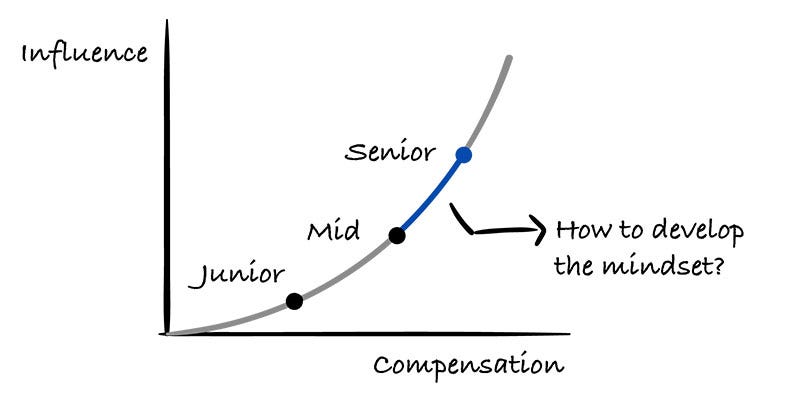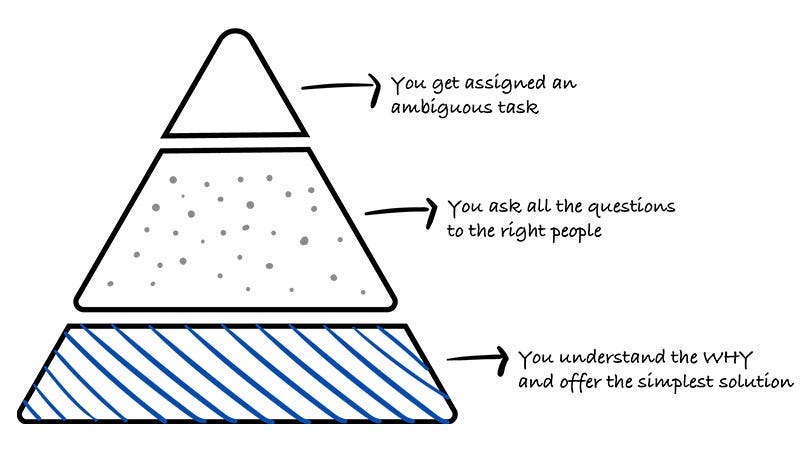How to Develop a Senior Mindset
5 specific real-world examples of the difference between Junior and Senior mindset!
Intro
I can tell a lot about engineer's seniority by the way they approach solving problems. Are they really taking care of the problem? Or do they just accept the first solution they come across and leave it for others to deal with?
As a manager, I wish to rely on Senior engineers to make the right decisions and inspire others to do the same.
To do that, they need to have the right mindset → a Senior mindset. It all starts here.
In this article, we’ll break down how you can develop such mindset. It’s the right time to focus on developing it, especially as AI progresses further and people with the right mindset will have bigger and bigger advantage in the market from other engineers who focuses primarily on tech skills.
And also, what’s important to mention is that attitude and mindset are what I value the most when I am assessing the potential in engineers. It’s what really makes the difference when I am looking at engineer’s ceiling.
This is an article for paid subscribers, and here is the full index:
- What exactly does a Senior mindset mean?
- How to approach developing a Senior mindset?
- How did I develop a Senior mindset?
1. Ask all the right questions before starting to solve the problem
🔒 2. REALLY take care of the problem, not just try to quickly patch it and leave it for others to deal with it
🔒 3. Focus on simplifying the solution as much as possible
🔒 4. Know when the solution is good enough or when to optimize further
🔒 5. Self-aware and self-confident enough to admit when they don't know something
🔒 Last words
Let’s get straight into it!
What exactly does a Senior mindset mean?
There are many different versions of it and I’ll share my version:
A Senior mindset is a mindset that inspires trust in others.
People just know that you are someone that they can rely on to solve a problem when they have it. A Senior mindset is connected to the way you think, approach problems and operate daily.
It’s directly proportional to credibility, the better your credibility is, the more Senior your mindset is.
How to approach developing a Senior mindset?
There is no one-way approach that works and we are all different. It’s important that you find out what works for your case. However here are my three suggestions on how to approach it:
I highly suggest that you bookmark this article and apply the actionable points in different situations.
You need experience and you need to fail, make mistakes and learn from them. Embracing the process is key. Make sure to look at every mistake that you make as a learning opportunity.
Do a regular retrospective of your actions and think through them or compare them to the points mentioned in this article. I normally do a weekly retrospective of all my actions and I think through them whether I did the right thing or not and how would the best solution look like if I would rewind the time back.
How did I develop a Senior mindset?
I remember the start of my career, when I was a jr. engineer → I made many mistakes and one of them was that I wanted to act “smart” when I clearly didn’t have enough experience.
That has bitten me quite a few times, when I thought that I know exactly what is the way to go and what would be the “perfect” solution in a certain case. But after more senior engineers broke it down, it has shown that a different solution was a lot better fit after.
I made similar mistakes doing freelance projects as well. When I just went straight into building, without really thinking through if I am building the right thing.
Over time and after many mistakes and some wins, and over 11+ years (getting close to 12 now) in the engineering industry, I’ve come across many different situations both as an engineer and as a manager where I have either showed a Senior mindset or I know how would it look like.
And I am sharing a lot of different examples from my personal experience in this article with you.
Let’s get straight into specific examples!
1. Ask all the right questions before starting to solve the problem
This is the first and very important thing to always have in mind. Never just go straight into building and going into “solving” mode.
If you spend time in the beginning to really understand WHY something is the way it is and why this is really the problem, you will be able to:
build much more accurate technical solutions,
spend less time building them,
provide a lot more value to the business in a shorter amount of time.
You should have a set of questions ready whenever you need them and they should be both business/product and technical.
Here is my list:
Notion Template: List of questions to ask before making a technical decision
Use this list of 35+ product/business-oriented and technical questions to really understand WHY something is needed.
Paid subscribers, you can get the list of questions here: 🎁 Products for paid subscribers
Example
You are assigned a task, where you need to add another field to the table in the database.
Junior mindset → Goes straight into updating the model, writes a migration, opens a PR and that’s it.
Senior mindset → Starts asking questions:
Why are we adding this field? What’s the business goal behind it, is this part of a bigger task that needs to be finished?
How will it be used?
What values are expected?
Are there any specific localizations that we need to consider?
Should this field be required or optional? This has impact on UX.





